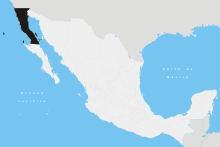Gold Coast (Baja California)
| Gold Coast Costa Dorada | |
|---|---|
| Region of the Baja California Peninsula | |
| Country |
|
| State |
|
| Largest city | Tijuana |
| Population | c. 2.2 million |
The Gold Coast (Spanish: Costa Dorada) is a northwestern region of the Baja California Peninsula. It is one of the most visited places in Mexico.[1] The Gold Coast is one of the richest, most educated, and most developed areas in Mexico.
Just south of California, the Gold Coast consists of the north western coastline on the Baja California Peninsula. Its urban area is a continuation of the South Coast urban area, and overall, extends from the Southern Californian city of Oxnard to Rosarito. The two regions share much cultural and economic exchange.
The largest cities of the Gold Coast are Tijuana, Ensenada, and Rosarito.
History
The modern day area of the Gold Coast traces its roots through thousands of years of prehistory when the Kumeyaay dwelt in the area.[2] The first European explorers to arrive to the area were Iberian sailors, the first being Juan Rodríguez Cabrillo in 1542, who journeyed the coastline. Under orders from the Viceroy of Mexico City, in 1602 Sebastián Vizcaíno mapped the coast of the Californias in detail looking for natural harbors for Spanish galleons.[3]
The region is part of an area that once belonged to Imperial Spain and was under the jurisdiction of the Province of the Californias. The Californias were split when Mexico won its independence from Spain into Alta California and Baja California. Following the Mexican–American War, the Californias became politically separated as California became a territory of the United States of America.
Ecology
The Baja California Gold Coast is located in an area where the California chaparral and woodlands terrestrial ecoregion is prevalent. This ecoregion within the Mediterranean forests, woodlands, and scrub biome also has similar sub-ecoregions where different types of flora and fauna exist including the California coastal sage and chaparral ecoregion.
Cities
The largest cities of the Baja California Gold Coast lie on a strip that runs from Tijuana to Ensenada. Urban development between these cities is nearly continuous.
The largest city in the area is cosmopolitan Tijuana and is known as the most visited border city in the world. T.J., as it is commonly known, is known for its cultural icon of Avenida Revolución. Tijuana's large tourism sector is also in part attributed to San Diego, with which it forms an international metropolitan area. Tijuana serves as an arts, music, culture, sports, and innovation center on the Gold Coast.[1] The city is also known for its industry, in which thousands are employed.
Within the Tijuana metropolitan area, coastal Rosarito Beach is a water sports and gringo seaside resort on the Gold Coast, 25 minutes south of the California - Baja California border. The city's economy is based on the revenue generated by its golf resorts, amusement park, and eco-tourist opportunities.[4] Rosarito is also home to the third largest cycling race in North America. Coined the Lobster Capital of the World, Rosarito cuisine focuses largely on sea food and shellfish.[1]
Ensenada is the second largest city on the Gold Coast and is approximately 74 miles (119 km) south of Tijuana.[5] Known as a center for wine production, the Guadalupe Valley of Greater Ensenada is a wine locality that in part began wineries in Napa Valley in the San Francisco Bay Area.[6] The Port of Ensenada, located near the heart of the city, maintains cargo and cruise terminals, in addition to smaller fishing marinas. Cruise ships arrive at the port from the nearby ports of Los Angeles, Long Beach, and San Diego.
Recreation
Bahia de Todos Santos is dotted with surfing locations that include Seven Sisters and Todos Santos Island. The coastline near Ensenada has several resort and marina communities at Baja Mar and La Salina. The Port of Ensenada is a cruise ship destination filled with sports fishing and marina amenities. The area around Bahia de San Quintin, two hours south, is a calmer area of the Gold Coast that lacks the large populace of the northern coastal resorts. San Quintin is a small rural community known for its hunting, fishing, sailing, and historical cultural opportunities.
See also
References
- 1 2 3 "The Baja Gold Coast / Discover Baja California". Archived from the original on April 20, 2011. Retrieved April 30, 2011.
- ↑ "California Indians and Their Reservations: P. SDSU Library and Information Access. (retrieved 21 May 2010)
- ↑ Bass, Stephen. "Basques in the Americas From 1492 to 1850: A Chronology" (PDF). Archived from the original (PDF) on July 28, 2011. Retrieved July 19, 2011.
- ↑ Gold Coast Resorts: Tijuana to Ensenada, Los Angeles Times, retrieved April 30, 2011
- ↑ "Tijuana - Ensenada Distance". mapquest. Retrieved July 19, 2011.
- ↑ "The History - Paralelo Wines, Mexico". Paralelo Wines, Mexico. Archived from the original on March 27, 2012. Retrieved July 19, 2011.
